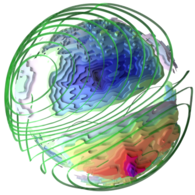Diese Seite ist zur Zeit leider nur in englischer Sprache verfügbar.
The Earth's atmosphere consists of several layers that differ in physical properties. The goal of the vertical coupling in Earth’s atmosphere at mid and high latitudes (VERA) project is to understand the coupling mechanisms by which the upper atmosphere (ca. 85-600 km) is influenced by the processes in the regions below. Our focus is on sudden stratospheric warming (SSW) events, during which the middle atmosphere (10-85 km) is highly disturbed. The ionosphere response to SSWs has previously been studied for low latitude regions, where forcing from the magnetosphere is indirect and relatively modest. VERA will assess the importance of vertical atmospheric coupling at mid- and high- latitudes, using observations from low Earth orbit (LEO) satellites and ground-based radars, as well as state-of-the-art numerical models. The conclusions derived from the analyses of these data can lead to a significant breakthrough on driving forces of the ionospheric weather.
ESA's satellite constellation mission, Swarm, will play a key role in the VERA project. Swarm's high precision magnetometers and its dedicated constellation for geospace research enable monitoring of the mid- and low-latitude inter-hemispheric field-aligned currents, which will be fully explored in VERA. In addition to the Swarm data, 10 years of CHAMP magnetometer data will be used to allow the opportunity to investigate more SSW events. These satellite observations will be enhanced by the analysis of ground-based ionospheric observations. Moreover, observational results will be supported by a recently-developed empirical model of the high-latitude ionosphere, E-CHAIM, and a physics-based model, TIEGCM.
Principal Investigators
- Dr. Yosuke Yamazaki (GFZ) - Primary Coordinator
- Prof. Dr. Claudia Stolle (GFZ)
- Prof. Dr. Jan Lastovicka (CAS)
- Dr. Petra Koucka Knizova (CAS)
- Prof. Dr. William Ward (UNB)
- Dr. David Themens (UNB)
Personnel
- Dr. Guram Kervalishvili (GFZ)
- Dr. Tarique Adnan Siddiqui (GFZ)
- Dr. Bernhard Fluche (GFZ)
- Dr. Jaroslav Chum (CAS)
- Dr. Dalia Buresova (CAS)
- Dr. Daniel Kouba (CAS)
- Dr. Zbysek Mosna (CAS)
- Dr. Michal Kozubek (CAS)
- Dr. Ilya Edemskiy (CAS)
- Dr. Sam Kristoffersen (UNB)
Sudden Stratospheric Warming (SSW)
SSW events from 2008 to 2018: Nov 2008 - Apr 2009.jpeg | Nov 2009 - Apr 2010.jpeg | Nov 2010 - Apr 2011.jpeg | Nov 2011 - Apr 2012.jpeg | Nov 2012 - Apr 2013.jpeg | Nov 2013 - Apr 2014.jpeg | Nov 2014 - Apr 2015.jpeg | Nov 2015 - Apr 2016.jpeg | Nov 2016 - Apr 2017.jpeg | Nov 2017 - Apr 2018.jpeg
Each figure shows, from the top to the bottom, daily values of the Northern Hemisphere polar temperature at 10 hPa (~32 km altitude); daily values of the meridional temperature gradient between 90˚N and 60˚N at 10 hPa; daily values of the zonal mean zonal wind at 60˚N and 10 hPa; daily values of the solar flux index F10.7; and daily sum of the geomagnetic activity index Kp. The occurrence of a sudden stratospheric warming (SSW) can be identified as a rapid increase in the polar temperature (>25 K in a week or less), the reversal of the meridional temperature gradient (T at 90˚N minus T at 60˚N) from negative to positive values, and the reduction or reversal of the zonal mean zonal wind in the stratosphere at 60˚N. An SSW event is called "major" when the direction of the zonal mean zonal wind at 60˚N and 10 hPa changes from eastward to westward; otherwise the event is called "minor". The ionospheric variability results not only from SSWs but also from solar and magnetospheric sources. The F10.7 index is a proxy for the solar energetic radiation flux into the Earth's upper atmosphere. The Kp index quantifies geomagnetic activity, which is closely related to the activity level of the magnetosphere. Geomagnetic activity is considered to be high when the daily sum of the Kp index is 23 or more.
Paper
- Lühr, H., Kervalishvili, G. N., Stolle, C., Rauberg, J., Michaelis, I. (2019), Average characteristics of low-latitude interhemispheric and F-region dynamo currents deduced from the Swarm satellite constellation, Journal of Geophysical Research: Space Physics, 124, 10631–10644, https://doi.org/10.1029/2019JA027419.
- Yamazaki, Y., Matthias, V., Miyoshi, Y., Stolle, C., Siddiqui, T., Kervalishvili, G., Laštovička J., Kozubek M., Ward W., Themens D. R., Kristoffersen S., Alken P. ( 2020), September 2019 Antarctic sudden stratospheric warming: quasi‐6‐day wave burst and ionospheric effects. Geophysical Research Letters, 47, e2019GL086577, https://doi.org/10.1029/2019GL086577.
- Park, J., Yamazaki, Y., Lühr, H. ( 2020), Latitude dependence of interhemispheric field‐aligned currents (IHFACs) as observed by the Swarm constellation. Journal of Geophysical Research: Space Physics, 125, e2019JA027694, https://doi.org/10.1029/2019GL086577.
- Kozubek, M., Lastovicka, J., Krizan, P. (2020), Comparison of Key Characteristics of Remarkable SSW Events in the Southern and Northern Hemisphere. Atmosphere, 11, 1063, https://doi.org/10.3390/atmos11101063.
Report
- Yamazaki, Y., Stolle, C., Siddiqui, T., Laštovička, J., Mošna, Z., Kozubek, M., Ward, W., Themens, D. R., Kristoffersen, S. (2020) VERA: VERtical coupling in Earth’s Atmosphere at mid and high latitudes − Final Report, Potsdam, German Research Centre for Geosciences GFZ, pp. 1-138, https://doi.org/10.2312/GFZ.2.3.2020.001.
Conference Paper
- Yamazaki, Y., Stolle, C., Lastovicka, J., Koucka Knizova, P., Ward, W., Themens, D., et al. (2019), VERA: Vertical Coupling in the Earth’s Atmosphere at Mid and High Latitudes, 9th Swarm Data Quality Workshop (Prague, Czech Republic)



